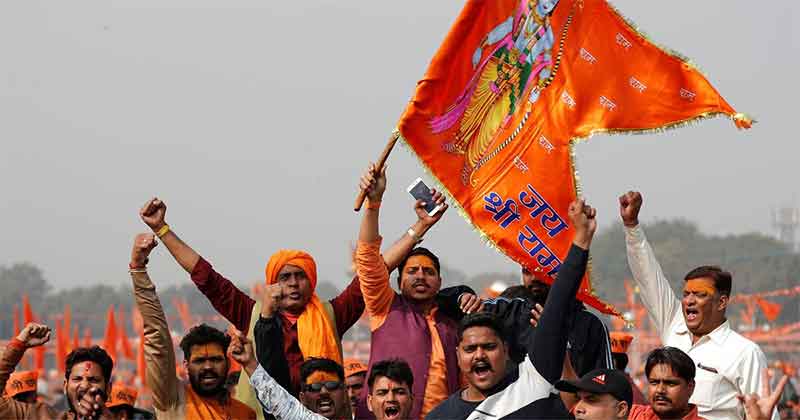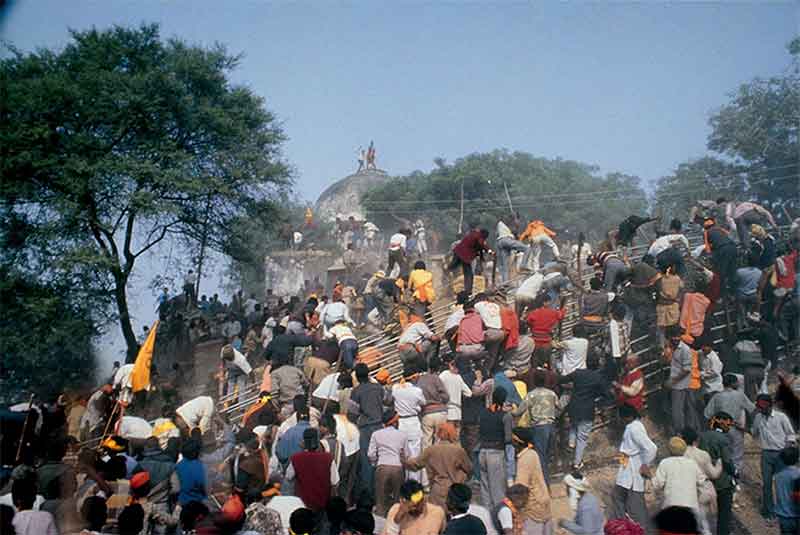
It is the morning of January the 22nd, in the year 2024. As I drive back from terminal two of the Mumbai airport on a personal errand, a sight captures my attention. There is a huge national flag of India which has been hoisted in the airport premises for some time now. But it does not fly today. It is lank, hanging low, perhaps because of the direction of the wind. Right behind it, at some distance is a saffron flag. I do not recollect if it was always there, but it today it is more visible than usual as it flew, stood erect in all its glory. Together the placing of both flags paints a sordid image; our tricolor bowed down under the heavy burden of sectarianism and threat of impending ethnic cleansing of thousands of Indians, while the saffron flag buoyed heralding an era of totalitarianism. For the sake of perspective let it be known, that January the 22nd marks the political consecration of Lord Ram’s idol in a newly albeit incomplete temple at Ayodhya. The incomplete temple stands where once stood the Babri Masjid. The Babri Masjid supposedly stood where once rested an ancient Ram temple. A conspicuous circle of correcting perceived historical injustices with even greater injustices seems to be in place; who cares if Gandhi, a devout follower of Ram himself, believed ‘an eye for an eye will make the whole world blind.’
India is a secular republic, meaning, one has the right to practice and profess their faith. While the consecration of the Ram temple might be viewed by some as an exercise of this right, there is an insidious silence about the State’s vulgar and ostentatious participation in the same. An unholy alliance between State and religion, which was formed back in 2014, has come to full force for this occasion. Sociologically speaking, the State has displayed an impeccable understanding of the effectiveness of operationalizing both the Intellectual State Apparatus (ISA) and Repressive State Apparatus (RSA) to its benefit. The concept of ISA and RSA has been coined by Louis Althusser. Althusser, a structuralist Marxist discusses the relation between the state and its subjects. Althusser is asking why subjects are obedient, why people follow the laws, and why there is not a revolt, how does the State create legitimacy etc. He mentions two major mechanisms for insuring that people within a state behave according to the rules of that state, even when it is not in their best interests. The first is what Althusser calls the RSAs, or Repressive State Apparatuses, that can enforce behaviour directly, such as the police, administration, and the criminal justice system. Through these ‘apparatuses’ the state has the power to force you physically to behave. More important, however, is the second mechanism Althusser investigates, which he calls ISAs, or Ideological State Apparatuses. These are institutions which generate ideologies which we as individuals (and groups) then internalize, and act in accordance with. These ISAs include schools, religions, the family, civil society, politics, arts, media, sports – organizations that generate systems of ideas and values. The ISA is not blunt and covert like the RSA and hence has greater chances of successfully depositing illusions that the State would like its citizens. While the RSAs have been deployed at multiple junctures, at multiple points of time in the journey of demolition to the mosque to the present-day consecration ceremony in the favour of majoritarian sentiments; the government has won the battle of communalising the secular middle class of India by deploying ISAs shrewdly. Social media platforms have been systematically bombarded with news that stokes communal hate against Muslims, creating an illusion of fear that would be placated only by the supposed return of Lord Ram; therefore, the chant ‘Ram Ayenge’. There has been a slew of Hindi movies endorsing microaggressions against minorities, glorifying the idea of Hindu Rashtra with very twisted interpretations of constitutional values of liberty, freedom, equality, fraternity, and secularism. The ISA and RSA have together been able to create this legitimacy which has normalised the celebration of a religious function at a national level, rivalling occasions like Republic Day and Independence Day. It has also normalised the imposition of a celebration by a select few on the masses- groups of men and women are ringing bells, knocking on doors of all houses demanding participation in arti and puja to mark the consecration, light diya etc. Denial to participate carries the risk of ostracization. Public holidays have been declared by the State under the assumption that the consecration is not a religious rather national concern. Essential services which continued to operate during the COVID-19 pandemic have been directed to announce at least a half day in celebration of the consecration. The Prime Minister of the Republic of India is participating in the consecration of the Ram temple. Perhaps creating a new definition of the ‘temples of modern India,’ one which will be different from that conceptualised by another Prime Minister- Jawaharlal Nehru, who believed dams, industries and educational institutions would be temples of modern India.
If one moves beyond sentiment, it is evident that the political, social, and economic costs of the temple building, its inauguration and upkeep are phenomenally high. The Ram Temple is among the most expensive religious projects in India in recent years, with an estimated cost of ₹1,800 crore, as per several journalistic reports. The government seems to have gone overboard with expenditure for the consecration ceremony, blurring lines between the taxpayer’s money and the Shree Ram Janmbhoomi Kshetra Trust money – thousands of VIPs being ferried across on government funding, dining on government funding, procuring security on government funding, not to mention the economic cost of declaring public holiday on an otherwise working Monday. While there are claims that the Ram mandir will bring more than thousand crores to the Uttar Pradesh government via tourism, to whose benefit will these funds be diverted, what purposes it is deployed remains unknown. One thing is for certain that it will not be diverted towards health or education crisis in Uttar Pradesh, with development indicators being abysmally poor, not just in UP but the whole of India. Does the Indian State have the luxury of affording this blatant display of wealth and glamour while lakhs of Indians languish in poverty and illiteracy. The answer does not really matter if it is the name of Ram. Politically, it will cost India its secular, liberal and democratic image, not just domestically but also on the international stage. Several democracy-watching organizations classify India today as a “hybrid regime”—that is, neither a full democracy nor a full autocracy. In 2021, Freedom House dropped India’s rating from Free to Partly Free (the only remaining category is Not Free). One wonders what its results would be in the year 2024. Socially, the nature of the consecration ceremony has pushed India back a hundred, if not thousand years back in time. The consecration ceremony and the Shree Ram Janmbhoomi Kshetra Trust fare poorly in terms of inclusion of the marginalised communities of India. The pranprathistha ceremony is being orchestrated buy a systematic of cohort of caste Hindu men – Brahmin preists, brahmin yajman and other savarna sankritised Hindus. The wife of the yajman is the only woman present but in vestigial attendance, much like Sita’s role in the consecration- lurking in the shadows of Ram. The practice or even mere idea of inclusivity, equity seem superficial if reports are to be believed. While anyone and everyone is free visit the temple for darshan, their participation and role in the hyped consecration is that of mere spectators. It is shocking how people travelling thousand kilometres to meet their beloved Ram are content being alienated from him by boundaries of caste, gender, class, and power. Naturally certain questions come to mind; what is the nature of roles women are likely to play in this temple, whether women will be permitted within the sanctum sanctorum, where do the LGBTQIA+ individuals stand in this arrangement, what about the thousands of labourers (most of whom belong to marginalised groups) who built the temple – overworked, underpaid, exploited and opiated at the behest of religion, or what role do the so called lower castes play here, after all, the history of Hindu temples as being centres of caste based discrimination cannot be forgotten. These are only some questions which have been conveniently left unanswered.
Questions that have been raised by this article are neither an endorsement nor an opposition to the idea of the temple being made in the name of Ram. However, it calls for an urgent need to recognise that the politics and economics behind of the issue at hand has potentially desecrated the sanctity and purity associated with the most revered deity in Indian mythology. As I conclude writing, I hear cries of Jai Shree Ram, Bharat Mata ki jay from the by lanes of my apartment, it sends chills up the spine. This cannot be the India of our imagination, this cannot be the purpose of years of freedom struggle, this cannot be why thousands of Indians sacrifice their blood and sweat – some on the borders, some at the grassroot. Whatever happened to the Ambedkarite thought of ‘being Indian, firstly and lastly’ or the Nehruvian thesis of a scientific and rational nation, or Shastri’s ideology of ‘Jai Jawan Jai Kisan’? What stands before us is a nation where capitalism and communitarianism have joined hands to create an ungodly spectre, where everyone must pass the agnipariksha (test by fire) to prove their love for the nation set by hegemonic standards of a saffronised state. I do not know whether the future topple the existing order but today, I reject this version of nationalism and my head hangs in shame at the thought of the nation we pass on to the future generations of Indians.
Bhavya Kumar hails from Lucknow. She is a doctoral research scholar at the Centre for Studies in Sociology of Education at Tata Institute of Social Sciences, Mumbai. She is currently working on her doctoral thesis; Self & Multiple Others: Social Interactions in a Classroom Situation. She has twelve years of training as a social scientist, having done a B.A (H) in Economics from the University of Delhi and a subsequent Masters in Sociology from Jawaharlal Nehru University.














































